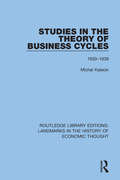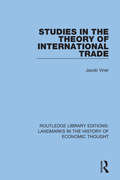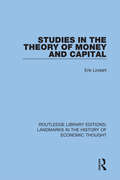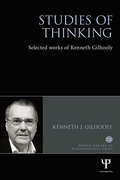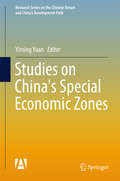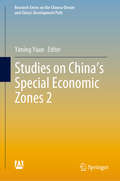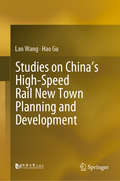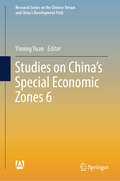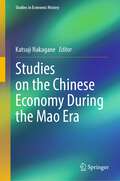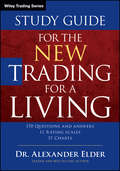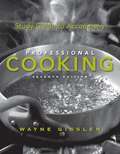- Table View
- List View
Studies in the History of Monetary Theory: Controversies and Clarifications (Palgrave Studies in the History of Economic Thought)
by David GlasnerThis book presents an alternative approach to monetary theory that differs from the General Theory of Keynes, the Monetarism of Friedman, and the New Classicism of Lucas. Particular attention is given to the work of Hawtrey and his analysis of financial crises and his explanation of the Great Depression. The unduly neglected monetary theory of Hawtrey is examined in the context of his contemporaries Keynes and Hayek and the subsequent contributions of Friedman and of the Monetary Approach to the Balance of Payments.Studies in the History of Monetary Theory aims to highlight the misunderstandings of the quantity theory and the price-specie-flow mechanism and to explain their unfortunate consequences for the subsequent development of monetary theory. The book is relevant to researchers, students, and policymakers interested in the history of economic thought, monetary theory, and monetary policy.
Studies in the Theory of Business Cycles: 1933-1939 (Routledge Library Editions: Landmarks in the History of Economic Thought)
by Michal KaleckiThis volume, originally published in 1966, contains essays from the 1930s and is valuable not only in the context of the history of thought. It provides an excellent introduction to the general theory of employment, interest and money and reflect the most essential features of Kalecki’s theory of the business cycle.
Studies in the Theory of International Trade (Routledge Library Editions: Landmarks in the History of Economic Thought #15)
by Jacob VinerIn this book, originally published in 1937, Jacob Viner traces, in a series of studies of contemporary source-material, the evolution of the modern orthodox theory of international trade from its beginnings in the revolt against English mercantilism in the 17th and 18th centuries, through the English currency and tariff controversies of the 19th century, to the late 20th century. The author offers a detailed examination of controversies in the technical literature centering on important propositions of the classical and neo-classical economists relating to the theory of the mechanism of international trade and the theory of gain from trade.
Studies in the Theory of Money and Capital (Routledge Library Editions: Landmarks in the History of Economic Thought)
by Erik LindahlIt is well-known that the Swedish experiment in practical economic control was inspired by a simultaneous development of economic thought in Sweden. Despite Swedish economics being known globally, until this book was originally published in 1939 there was little except second-hand descriptions of what the Swedes were really saying. This volume remedied that and explained hitherto hidden contemporary Swedish monetary theory.
Studies of Company Records: 1830-1974 (Routledge Library Editions: Accounting)
by J. R. EdwardsThis anthology comprises a selection of articles which demonstrates the explanatory potential of company records as source material for the accounting historian. They were published in the UK and the USA between 1954 and 1984. The articles reproduced are based on the records of what is the modern business enterprise and they identify and explain the development of external financial reporting procedures.
Studies of Labor Market Intermediation
by David H. AutorFrom the traditional craft hiring hall to the website Monster. com, a multitude of institutions exist to facilitate the matching of workers with firms. The diversity of such Labor Market Intermediaries (LMIs) encompasses criminal records providers, public employment offices, labor unions, temporary help agencies, and centralized medical residency matches. Studies of Labor Market Intermediation analyzes how these third-party actors intercede where workers and firms meet, thereby aiding, impeding, and, in some cases, exploiting the matching process. By building a conceptual foundation for analyzing the roles that these understudied economic actors serve in the labor market, this volume develops both a qualitative and quantitative sense of their significance to market operation and worker welfare. Cross-national in scope,Studies of Labor Market Intermediation is distinctive in coalescing research on a set of market institutions that are typically treated as isolated entities, thus setting a research agenda for analyzing the changing shape of employment in an era of rapid globalization and technological change.
Studies of Thinking: Selected works of Kenneth Gilhooly (World Library of Psychologists)
by Kenneth J. GilhoolyIn the World Library of Psychologists series, international experts themselves present career-long collections of what they judge to be their finest pieces - extracts from books, key articles, salient research findings, and their major practical theoretical contributions. Kenneth Gilhooly has an international reputation as an eminent scholar and pioneer in the field of thinking and reasoning. The book covers key works on problem solving, expertise, working memory and thinking, and ageing. A specially written introduction gives an overview of his career and contextualises the selection in relation to changes in the field during this time. The book enables the reader to trace developments in thinking and reasoning over the last forty years.It will be essential reading students and researchers of cognitive psychology interested in the history of thinking and reasoning.
Studies on China's Special Economic Zones
by Yiming YuanThis book offers an authoritative study on special economic zones in China. With articles from economic experts and scholars, the scope of the book includes new theories, methods and discoveries in the field of special economic zone studies. It foscuses on discussing recent advances in the area, including research on current industrial upgrade and transformation, the development patterns of special economic zones, innovation construction and special-economic-zone system innovation. It offers a valuable data source for economics undergraduates and postgraduates, economics researchers at social science institutions and government officals.
Studies on China's Special Economic Zones 2 (Research Series on the Chinese Dream and China’s Development Path)
by Yiming YuanThe book provides an authoritative study on Special Economic Zones. The scope of the articles will include new theories, methods and discoveries in SEZ study, and specifically provide recent achievements in Special Economic Zones. The journal is aimed at economics undergraduates, postgraduates, economics researchers in social science institutions and the government. Special Economic Zone mode provides an easy approach to complete modernization in developing countries like China, the reader can get some important data source and major results in this area.
Studies on China's Special Economic Zones 3 (Research Series on the Chinese Dream and China’s Development Path)
by Yiming YuanThe book provides an authoritative study on Special Economic Zones. The scope of the articles will include new theories, methods and discoveries in SEZ study, and specifically provide recent achievements in Special Economic Zones. The volume's content is aimed at economics undergraduates, postgraduates, economics researchers in social science institutions and the government. The implementation of Special Economic Zones provides an easy approach to complete modernization in developing countries like China, and the reader can obtain some important sources of data, as well as major results in this area.
Studies on China’s High-Speed Rail New Town Planning and Development
by Lan Wang Hao GuThis book focuses on high-speed rail (HSR) and new town planning and development related to HSR, approaching the issue from three different perspectives: economic cooperation at a regional level; HSR-based economic growth point at a city level; and mixed land use and building environment in the periphery area of HSR stations. On the basis of simulations and case studies, it proposes practical planning principles and suggestions for area development, providing planners with a theoretical framework to incorporate the transportation system into new town planning. It also serves as a valuable reference source for the authorities, enabling them to make evidence-based and rational decisions.
Studies on China’s Special Economic Zones 4 (Research Series on the Chinese Dream and China’s Development Path)
by Yiming YuanThis book collects articles on the achievements and experience of special economic zones during the China’s Reform and Opening-up in the past 40 years. The topics ranges from a historical summary of the development in special economic zones to its future prospect. Most of the articles analyze the policies applied for special economic zones and how they contributed to the economic growth, which provides the readers with an overview about how public policies helped cities develop. Some of the articles shift their focus to the role of special economic zones in larger area, i.e., Asia. These works exemplify the impact of China’s economic policies in long term. Moreover, the book includes the contribution of special economic zones to the economic development world-wide, such as places in Africa and areas of “One Belt One road”. Reader can benefit a thorough understanding of China’s special economic zones’ past and future through reading the book.
Studies on China’s Special Economic Zones 5 (Research Series on the Chinese Dream and China’s Development Path)
by Yiming YuanThis book collects the latest academic achievements, research progress and policy propositions on the study of China’s special economic zones, with the aim to reflect the history, new development and new challenges of the construction of Chinese special economic zones. It presents the successful experience of the development of Guangdong–Hong Kong–Macao Greater Bay Area and the changes of its mission and analyzes the problems encountered in the development of Shenzhen special economic zones and the theory of economic system reform.
Studies on China’s Special Economic Zones 6 (Research Series on the Chinese Dream and China’s Development Path)
by Yiming YuanThis book reflects the latest academic achievements, research progress and policy propositions on China’s special economic zones study. This book analyzes the problems encountered in thedevelopment of China’s basic special economic zones and the theory of economicsystem reform, introduces the achievements and prospects of the development ofChina’s special economic zones in the past 40 years of reform and opening-up, explores the successful experience of the special economic zones as China’snew economic system, and conducts the comparative study with Shanghai Pudong New Area, Singapore and Hong Kong regarding of the rise of the finance industry.
Studies on the Abuse & Decline of Reason: Text and Documents (The Collected Works of F.A. Hayek)
by F.A. HayekStudies on the Abuse and Decline of Reason is a series of fascinating essays on the study of social phenomena. How to best and most accurately study social interactions has long been debated intensely, and there are two main approaches: the positivists, who ignore intent and belief and draw on methods based in the sciences; and the nonpositivists, who argue that opinions and ideas drive action and are central to understanding social behavior. F. A. Hayek’s opposition to the positivists and their claims to scientific rigor and certainty in the study of human behavior is a running theme of this important book. Hayek argues that the vast number of elements whose interactions create social structures and institutions make it unlikely that social science can predict precise outcomes. Instead, he contends, we should strive to simply understand the principles by which phenomena are produced. For Hayek this modesty of aspirations went hand in hand with his concern over widespread enthusiasm for economic planning. As a result, these essays are relevant to ongoing debates within the social sciences and to discussion about the role government can and should play in the economy.
Studies on the Abuse and Decline of Reason: Text and Documents (The Collected Works of F. A. Hayek Ser. #13)
by F. A Hayek"The studies of which this book is the result have from the beginning been guided by and in the end confirmed the somewhat old-fashioned conviction of the author that it is human ideas which govern the development of human affairs," Hayek wrote in his notes in 1940. Indeed, Studies on the Abuse and Decline of Reason remains Hayek’s greatest unfinished work and is here presented for the first time under the expert editorship of Bruce Caldwell. In the book, Hayek argues that the abuse and decline of reason was caused by hubris, by man’s pride in his ability to reason, which in Hayek’s mind had been heightened by the rapid advance and multitudinous successes of the natural sciences, and the attempt to apply natural science methods in the social sciences.
Studies on the Chinese Economy During the Mao Era (Studies In Economic History Series)
by Katsuji Nakagane<p>This book focuses on several specific features characterizing China’s economy in the Mao era (1952–1976), and discusses whether and how they are related to the new economic strategy called “reforms and opening-up” under Deng Xiaoping’s leadership with the result of the aftermath of well-known rapid growth.<p> <p>It provides the reader with basic knowledge of the continuity and discontinuity between the Mao and Deng eras. Readers are provided with some important clues for thinking about how Maoist China could have contributed to or alternatively prevented today’s economic development. The topics addressed here include a brief overview of economic development under Mao, significant differences between Mao and Deng economics, and socialist transformations during the early Mao era. These include collectivization as well as communization and the effects on agricultural productivity; water supply construction drives utilizing a vast amount of rural surplus labor; rural finance; the effects on national savings, and the development of heavy and light industry. Also considered are the effects on the socialist industrialization, rural small-scale industries during the Cultural Revolution and their aftermath, and the realities of social life in a Third-front construction site promoted by Mao’s military strategy in the 1960s. This book is highly recommended to readers who are interested in contemporary China’s economy, particularly to scholars and students. The volume gives new insight into the background or preconditions that made possible historically rare miracles of the Chinese economy after Mao.<p>
Studio Craft & Technique for Architects Second Edition
by Anne Gorman Miriam DelaneyThis one-stop handbook for architecture students provides step-by-step techniques for perfecting the vital skills of drawing, model making and surveying. It is a primer on the conventions of architectural representation and the use of materials. It also explains the primary elements of construction and structure from first principles, using clear diagrams and drawings. Recommended in the first year at numerous architecture schools, this second edition has been updated to include a new section on sustainability, more on types of drawing and when to use them, and more on structural principles and materials.
Studio Craft & Technique for Architects Second Edition
by Anne Gorman Miriam DelaneyThis one-stop handbook for architecture students provides step-by-step techniques for perfecting the vital skills of drawing, model making and surveying. It is a primer on the conventions of architectural representation and the use of materials. It also explains the primary elements of construction and structure from first principles, using clear diagrams and drawings. Recommended in the first year at numerous architecture schools, this second edition has been updated to include a new section on sustainability, more on types of drawing and when to use them, and more on structural principles and materials.
Studio Moderna--A Venture in Eastern Europe
by Daniel J. IsenbergStudio Moderna is the leading electronic retailer in 20 countries in and around Central and Eastern Europe, and use a multi-channel business strategy, organizational structure, and IT system. When management conflicts arise, Sandi Cesko, CEO and co-founder must decide whether to change his in-sourcing strategy to out-sourcing.
Studio Realty
by Clayton M. Christensen Bret BairdStudio Realty created an "electronic open house" technology, by which home buyers sitting in a comfortable setting, could tour a home, viewing its rooms, its exterior, and surroundings, by clicking on digital images. Studio Realty attempted to sell or license its system to realtors, but found that none were interested. Ultimately, its owners had to establish their own real estate agency in order to create demand for the technology. The case closes with the question of whether homes can be sold with this technology over the Internet.
Studio Shape Up: The Keys to Transforming Your Fitness Studio Into a Thriving Business
by Chelsea StreifenederWhether your goal is to open a new business, optimize the studio you have now, or take your profit up a few notches, Studio Shape Up provides the information you need to make your clients succeed and your studio prosper. There is no reason why fitness businesses shouldn&’t be thriving. This guide raises the bar for studio owners and simply leaps over the &“skills approach&” other books preach about. In building her own studio, Chelsea Streifeneder&’s goal was to build a community of happy people who know how to play as hard as they work and who understand that fun is an important part of a healthy lifestyle, and now she aims to share her tools with others along with what is and isn&’t working for her. Studio Shape Up is like having your own personal business advocate, telling you exactly the right moves to make at the right time to achieve the greatest possible results. This timely gem changes the way studio owners can build, grow, and make their business the best it&’s ever been!
Study Guide for Statistics for Business and Financial Economics
by Ronald L. Moy Li-Shya Chen Lie Jane KaoThis Study Guide accompanies Statistics for Business and Financial Economics, 3rd Ed. (Springer, 2013), which is the most definitive Business Statistics book to use Finance, Economics, and Accounting data throughout the entire book. The Study Guide contains unique chapter reviews for each chapter in the textbook, formulas, examples and additional exercises to enhance topics and their application. Solutions are included so students can evaluate their own understanding of the material. With more real-life data sets than the other books on the market, this study guide and the textbook that it accompanies, give readers all the tools they need to learn material in class and on their own. It is immediately applicable to facing uncertainty and the science of good decision making in financial analysis, econometrics, auditing, production and operations, and marketing research. Data that is analyzed may be collected by companies in the course of their business or by governmental agencies. Students in business degree programs will find this material particularly useful to their other courses and future work.
Study Guide for The New Trading for a Living
by Alexander ElderTest your trading knowledge and skills--without risking any moneyYou may read the best trading book, but how much of that knowledge will you retain a week later? This is why you need this Study Guide for The New Trading for a Living. It'll give you a firmer grasp of the essential trading rules and skills. This Study Guide, based on the bestselling trading book of all time, was created by its author to help you master the key points of his classic book.The Study Guide's 170 multiple-choice questions are divided into 11 chapters, each with its own rating scale. They cover the entire range of trading topics, from psychology to system design, from risk management to becoming an organized trader. Each question is linked to a specific chapter in the main book, while the Answers section functions like a mini-textbook. It doesn't just tell you that A is right or B is wrong--it provides extensive comments on both the correct and incorrect answers.This Study Guide also contains 17 charts that challenge you to recognize various trading signals and patterns. Everything is designed to help you become a better trader.Consider getting two books as a package--the Study Guide and The New Trading for a Living. They're designed to work together as a unique educational tool. The Study Guide for The New Trading for a Living is a valuable resource for any trader who wants to achieve sustainable market success.
Study Guide to Accompany Professional Cooking (7th Edition)
by Wayne Gisslen Mary Ellen GriffinThe "Study Guide to Accompany Professional Cooking, Seventh Edition" is a useful tool to help students study and review the material in the textbook "Professional Cooking. " It contains 35 chapters of key exercises related to key terms; true/false questions; completion, short-answer, and other written exercises; and math exercises. The purpose is to reinforce learning, support your study efforts, and assist you in mastering the material.

